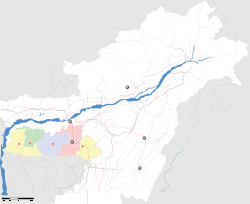- Mawsynram
-
Mawsynram — jacob — Coordinates 25°17′N 91°21′E / 25.28°N 91.35°ECoordinates: 25°17′N 91°21′E / 25.28°N 91.35°E Country India State Meghalaya District(s) East Khasi Hills Time zone IST (UTC+05:30) Mawsynram is a village in the East Khasi Hills district of Meghalaya state in north-eastern India, 56 kilometers from Shillong. It is reportedly the wettest place on Earth, with an annual rainfall of 11,872 millimetres (467.4 in). According to the Guinness Book of World Records Mawsynram received an incredible 26,000 millimetres (1,000 in) in 1985.
Oxford geographer Nick Middleton's book on people who live in extreme climates, Going to Extremes (ISBN 0-330-49384-1), chronicles his visit to the village, and describes how the inhabitants cope with such extreme precipitation.
Contents
Location
Mawsynram is located at 25º 18' N, 91º 35' E, its altitude is about 1,400 metres (4,600 ft).Mawsynram is located about 16 km west of Cherrapunji, on the Khasi Hills. Name of village contains Maw, a Khasi word meaning stone and thus might refer to certain megaliths in surroundings[1]. Khasi Hills are rich with such megaliths - Khasi monoliths erected fairly recently to commemorate important events and people.
Rainfall
Based on the data of a recent few decades, Mawsynram, located about 15 km north-west of Cherrapunji in the state of Meghalaya (India) appears to be the wettest place in the world or the place with the highest average annual rainfall. However, the village does not have a proper meteorological station and NOAA indicates Lloró in Colombia as the wettest place on Earth.[2] Mawsynram, receives nearly 12 m of rain in an average year, and a vast majority of it falls during the monsoon months. A comparison of rainfalls for Cherrapunji and Mawsynram for some years is given in Table 1.[3]
Table 1: Comparison of rainfalls for Cherrapunji and Mawsynram for some years.
Year Cherrapunji Rainfall (mm) Mawsynram Rainfall (mm) 2002 12,262 11,300 2001 9,071 10,765 2000 11,221 13,561 1999 12,503 13,444 1998 14,536 16,090 Three reasons can be cited for high rainfall at Mawsynram:
1. The warm moist winds of the northward-moving air from the Bay of Bengal during the monsoon, which cover an extensive area but are forced to converge into the narrower zone over the Khasi Hills, thus concentrating their moisture.
2. The alignment of the Khasi Hills (east to west) places them directly in the path of the airflow from the Bay of Bengal, producing a significant uplift (plus cooling, further condensation and thus more rain).
3. Finally, uplift over the Khasi Hills is virtually continuous in the monsoon period because the lifted air is constantly being pulled up by vigorous winds in the upper atmosphere, hence the rainfall is more or less continuous.
Natural landmarks
Located in Mawsynram, is a cave named Mawjymbuin. Inside this cave is a pair of notable speleothems - breast-shaped stalactite over a massive stalagmite which is shaped by nature into a Shivalinga[4]. Also found here is loaf-shaped rocky dome with a nearly flat top among the hillocks. It is called Symper Rock.
External links
References
- ^ "Mawsynram". Wondermondo. 2010-08-28. http://www.wondermondo.com/Countries/As/India/Meghalaya/Mawsynram.htm. Retrieved 2010-08-29.
- ^ "NCDC: Global Measured Extremes of Temperature and Precipitation". http://www.ncdc.noaa.gov/oa/climate/globalextremes.html.
- ^ The Tribune, Chandigarh, August 2003.
- ^ "Mawjymbuin Cave". Wondermondo. 2010-08-28. http://www.wondermondo.com/Countries/As/India/Meghalaya/Mawjy.htm. Retrieved 2010-08-29.
Categories:- Villages in East Khasi Hills district
- Weather extremes of Earth
Wikimedia Foundation. 2010.


